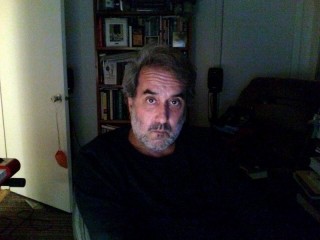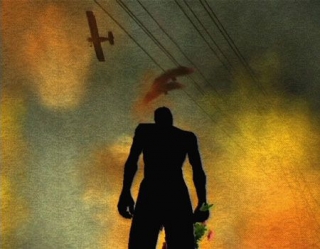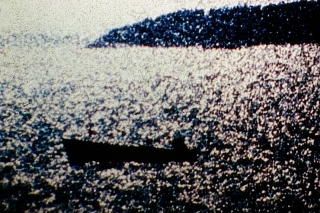Date: 24 October 2011 | Season: London Film Festival 2011, Phil Solomon | Tags: London Film Festival
FEEL FLOWS: THE FILMS OF PHIL SOLOMON
Monday 24 & Thursday 27 October 2011
London Tate Modern
On his first visit to the UK, Phil Solomon presents two programmes of his alchemical film work. By treating the celluloid surface with a variety of substances and techniques, Solomon transforms images to construct an emotionally charged and deeply affecting cinema. Often elegiac in tone, his symphonic approach makes the personal profound.
This survey of Solomon’s 16mm films also features Rehearsals for Retirement, a machinima work from the digital series In Memoriam (for Mark LaPore), made with imagery drawn from the Grant Theft Auto videogames. Programme two includes Seasons…, a collaboration with Solomon’s colleague, friend and mentor Stan Brakhage.
“Although part of a long avant-garde tradition, Solomon makes films that look like no others I’ve seen. The conceit of the filmmaker as auteur has rarely been more appropriate or defensible – the liberating effect of Solomon’s work suggests a rather different realm: Film Meets Vision, Rejoice!” (Manohla Dargis, New York Times
PHIL SOLOMON: PROGRAMME 1: Mon 24 Oct 2011
PHIL SOLOMON: PROGRAMME 2: Thur 27 Oct 2011
Curated by Mark Webber and presented in association with The 55th BFI London Film Festival.
Phil Solomon will premiere “American Falls” at BFI Southbank on Sunday 23 October 2011.
Back to top
Date: 24 October 2011 | Season: London Film Festival 2011, Phil Solomon | Tags: London Film Festival
PHIL SOLOMON: PROGRAMME 1
Monday 24 October 2011, at 7pm
London Tate Modern
THE EXQUISITE HOUR
Phil Solomon, 1989/94, 16mm, colour, sound, 14 min
“… Partly a lullaby for the dying, partly a lament of the death of cinema … [it] is dedicated to the memory of my grandparents, Albert Solomon, who was a projectionist for Fox, and Rose Solomon, who took tickets at Lowe’s Paradise in the Bronx.” (Phil Solomon)
THE SNOWMAN
Phil Solomon, 1995, 16mm, colour, sound, 8 min
“A meditation on memory, burial and decay – a belated kaddish for my father.” (Phil Solomon)
CLEPSYDRA
Phil Solomon, 1992, 16mm, b/w, silent, 15 min
“Solomon has evolved his technique so that in his latest work (‘Clepsydra’ – ‘waterclock’) the textures are constantly changing and are often appropriate to each figure in metaphoric interplay with each figure’s gestural (symbolic) movement. He has, thus, created consonance with thought as destroyer/creator – a Kali-like aesthetic ‘There is a light at the end of the tunnel’ (Romantic); and it is a train coming straight at us: … (and, to balance such, perhaps, with a touch of Zen) … it is beautiful!” (Stan Brakhage)
PSALM III: “NIGHT OF THE MEEK”
Phil Solomon, 2002, 16mm, b/w, sound, 23 min
“It is Berlin, November 9, 1938, and, as the night air is shattered throughout the city, the Rabbi of Prague is summoned from a dark slumber, called upon once again to invoke the magic letters from the Great Book that will bring his creature made from earth back to life, in the hour of need. A kindertodenliede in black and silver on a night of gods and monsters.” (Phil Solomon)
REHEARSALS FOR RETIREMENT
Phil Solomon, 2007, video, colour, sound, 10 min
“Had I known the end would end in laughter / I tell my daughter it doesn’t matter.” (Phil Ochs)
Back to top
Date: 27 October 2011 | Season: London Film Festival 2011, Phil Solomon | Tags: London Film Festival
PHIL SOLOMON: PROGRAMME 2
Thursday 27 October 2011, at 7pm
London Tate Modern
WHAT’S OUT TONIGHT IS LOST
Phil Solomon, 1983, 16mm, colour, silent, 8 min
“Adopting its title from a poem by Edna St. Vincent Millay, What’s Out Tonight Is Lost is an elegiac film sifting through the unrecoverable. The film is a reflecting pool where vision breaks up. The home we recognize is swallowed in the brume, the light barely penetrates; and the yellow school bus steals us away, delivering us into new clouds, embracing fear. The film has a surface of cracked porcelain and intaglio: the allergic childhood skin of cracks and bruises. This is a film of transubstantiations, the discorporation of human forms into embers. Air looms and blossoms into solidity and nearness … I hear it breathing …” (Mark McElhatten)
PSALM I: “THE LATENESS OF THE HOUR”
Phil Solomon, 2001, 16mm, colour, sound, 10 min
“A little Nachtmusik, a deep blue overture to the series. Breathing in the cool night airs, breathing out a children’s song; then whispering a prayer for a night of easeful sleep. My blue attempt at a sequel to Rose Hobart.” (Phil Solomon)
NOCTURNE
Phil Solomon, 1980, 16mm, b/w, silent, 10 min
“Its setting is a suburban neighbourhood populated by kids at play and indistinct but ominous parental figures. A submerged narrative rehearses a type of young boy’s night-time game in which a flashlight is wielded in a darkened room to produce effects of aerial combat and bombardment. A sense of hostility tinged with terror seeps into commonplace movements … Fantasy merges with nightmare, a war of dimly suppressed emotions rages beneath a veneer of household calm … In Nocturne, found footage is worked so subtly into the fabric of threat that its comes as a shock ploughed from the unconscious.” (Paul Arthur)
SEASONS …
Phil Solomon & Stan Brakhage, 2002, 16mm, colour, silent, 15 min
“Brakhage’s frame by frame hand carvings and etchings directly into the film emulsion, sometimes combined with paint, are illuminated by Solomon’s optical printing, then edited by Solomon into a four part seasonal cycle‚. This film can be considered to be part of a larger work by Brakhage entitled “…”. Seasons… is inspired by the colours and textures found in the woodcuts of Hokusai and Hiroshige, and the playful sense of forms dancing in space from the filmworks of Robert Breer and Len Lye.” (Phil Solomon)
REMAINS TO BE SEEN
Phil Solomon, 1989/94, 16mm, colour, sound, 17 min
“In the melancholic Remains to Be Seen, dedicated to the memory of Solomon’s mother, the scratchy rhythm of a respirator intones menace. The film, optically crisscrossed with tiny eggshell cracks, often seems on the verge of shattering. The passage from life into death is chartered by fugitive images: pans of an operating room, an old home movie of a picnic, a bicyclist in vague outline against burnt orange and blue … Solomon measures emotions with images that seem stolen from a family album of collective memory.” (Manohla Dargis, Village Voice)
Back to top


